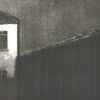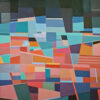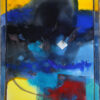Since its debut at the 53rd International Art Exhibition at the Venice Biennale in 2009, the National Pavilion UAE – La Biennale di Venezia (National Pavilion UAE) has emerged as a key figure in the UAE’s creative and cultural ecosystem, cementing its status at the forefront of original research and exhibition-making, both regionally and internationally. Drawing from the UAE’s rich and multilayered cultural fabric, the National Pavilion UAE curates untold stories that challenge preconceived notions, encourage collaboration, invite dialogue, and champion local talent.
Each exhibition tells a story, responds to a particular theme, and reveals an interesting aspect of the UAE’s historical and contemporary art and architecture scene.
Accompanying each exhibition is a comprehensive publication that elaborates on the themes explored. A product of rigorous research, the publication contributes extensive scholarship to further the disciplines of art history and architectural discourse in the region.
Situated within the Arsenale’s historic Sale d’Armi, behind an Istrian stone facade and arched portal (Fig.1), lies the National Pavilion UAE’s permanent ‘home’ in Venice, following an agreement signed in 2013 that secured the location for twenty years. The Salama bint Hamdan Al Nahyan Foundation has served as Commissioner of the National Pavilion UAE since its appointment by the UAE Ministry of Culture and Youth in 2014. Before 2014, the Pavilion’s first three participations at the Venice Biennale were commissioned by Dr. Lamees Hamdan. The Pavilion’s contemporary exhibition space has been transformed throughout the years to accommodate exhibitions of varying scenography and design, showcasing a variety of mediums, including film, sculpture, architectural models and drawings, archival material, and ephemera.
Parallel to its exhibitions at the Venice Biennale, the National Pavilion UAE also engages with local arts and cultural communities in the UAE through its robust public programming and professional opportunities designed to bolster these communities. In addition to establishing an expansive network of artists, architects, curators, and researchers through its various collaborations, the National Pavilion UAE’s Venice Internship program has supported the professional development of over 200 interns. The Venice Internship provides interns with hands-on experience, education, and training, where interns spend one month in Venice overseeing the Pavilion’s daily operations. Many former interns have gone on to have successful careers in the UAE’s expanding creative industries and cultural institutions.
As one of the first batch of interns at this year’s National Pavilion UAE at the Venice Biennale, I was able to experience first-hand the various preparations for setting up the exhibition and the excitement in the lead-up to its opening. As an aspiring curator, the opportunity to work alongside the National Pavilion team was especially invaluable for my professional development. I was particularly inspired by curator Maya Allison’s meticulous attention to detail and her curatorial approach to exhibition-making, as well as the unforgettable experience of speaking to artist Mohamed Ahmed Ibrahim about art and his practice— an artist in the truest sense of the word; it was an absolute privilege.
Here’s a look at the last eleven years of the National Pavilion UAE at the Venice Biennale.
Milestones
The National Pavilion UAE’s inaugural exhibition, curated by Tirdad Zolghadr and commissioned by Dr. Lamees Hamdan, was playfully titled, It’s Not You, It’s Me. It featured a photographic series by artist Lamya Gargash (Fig. 2), and artworks by UAE artists Hassan Sharif, Tarek Al Ghoussein, Ebtisam Abdulaziz, and Huda Saeed Saif, in addition to video interviews and recorded performances. Exploring the language of exhibition-making, the Pavilion recalled the tradition of a World’s Fair, showcasing architectural models of the UAE’s current and future arts infrastructure. The National Pavilion UAE’s bold entry as a first-time participant at the prestigious Venice Biennale was to set the stage for its future exhibitions.
In 2021, marking its tenth participation at the Biennale, and its fourth at the Architecture Exhibition, the National Pavilion UAE won the coveted Golden Lion award for best national participation for its exhibition Wetland. Curators Wael Al Awar and Kenichi Teramoto of Dubai-based architecture and design studio waiwai were selected following an international open call that invited architects, designers, and urban researchers to send proposals that responded to the question ‘How will we live together?’ set forth by Biennale curator Hashim Sarkis. Al Awar and Teramoto’s research examined the UAE’s vast and ecologically complex salt flats, or sabkhas, as inspiration to uncover the potential use of recycled waste brine leftover from desalination to create an alternative and more sustainable building material. The curators collaborated with various specialists and labs at New York University Abu Dhabi, the American University of Sharjah, and the University of Tokyo to develop their research.
Set against the backdrop of large-scale photographs of Al Ruwais sabkha by artist Farah Al Qasimi, the exhibition featured a prototype structure hand-built on-site and constructed from hand-cast modules with organic coral-inspired shapes that referenced the UAE’s traditional coral houses and vernacular architecture (Fig. 3). Accompanying Wetland was the publication titled The Anatomy of Sabkhas written by urban researchers Rashid and Ahmed Bin Shabib and co-edited by the curators. The publication explored the significance of these wetlands to the UAE’s natural environment and cultural heritage through case studies, personal essays, and photography. A supplementary volume written and edited by Aga Khan Award-winning architect Marina Tabbasum detailed the curators’ research journey for the exhibition.
Future-focused Wetland marked a shift from the National Pavilion UAE’s previous three participations at the Venice Biennale’s International Architecture Exhibition. Its first participation was in 2014 with Lest We Forget: Structures of Memory in the UAE, curated by Dr. Michele Bambling and commissioned by the Salama bint Hamdan Al Nahyan Foundation, which looked to the past to trace the history of the UAE’s architectural and urban development, chronicling its rapid growth and transformation from vernacular through to modern and contemporary, with particular emphasis on the early nation-building years of the 1970s and 1980s.
Based on the concept of the open archive, the exhibition allowed visitors to engage with cabinet drawers filled with primary material: drawings and renderings from architectural and engineering firms, official documents, aerial and historic photographs, and crowd-sourced personal family photo albums, alongside interactive maps and dynamic timelines (Fig. 4).
National Pavilion UAE & The Contemporary Art Scene in the UAE
This year’s National Pavilion UAE at the Venice Biennale features the work of Emirati artist Mohamed Ahmed Ibrahim in an exhibition titled Mohamed Ahmed Ibrahim: Between Sunrise and Sunset, curated by Maya Allison, Executive Director of The New York University Abu Dhabi Art Gallery. The single sculptural work consists of 128 papier-mâché parts of abstract and organic forms assembled on an elevated platform covering the length of the room. The sculptures vary in colour, transitioning from bright neons, depicting sunrise, to neutral earthy tones, and finally, monochromatic black and white, depicting sunset (Fig. 5).
Ibrahim sculpts these forms by draping layers of wet papier-mâché over a cardboard skeleton, which contorts and transforms as it adjusts to the weight of the papier-mâché before assuming a mutated form once dry. Ibrahim’s unique techniques and material knowledge are a by-product of his prolific career that spans nearly four decades as one of the UAE’s ‘Group of Five’ experimental and conceptual contemporary artists, along with Hassan and Hussain Sharif, Mohammed Kazem and Abdullah Al Saadi, many of whom have been featured at the National Pavilion UAE over the years.
‘The Group of Five’ acquired this moniker, having been featured in various exhibitions that referred to them as such. Hassan Sharif, the senior artist of the Group and mentor to many artists in the UAE, co-founded Al Tashkeel magazine in 1984, four years after the Emirates Fine Art Society was established, with his brother Hussain and artist Abdul Raheem Salem, amongst others.
The exhibition is accompanied by the monograph Mohamed Ahmed Ibrahim: Between Sunrise and Sunset / Works from 1986-2022. A retrospective of Ibrahim’s life and work to date, the publication is co-edited by curator Maya Allison and artist and curator Cristina De Marchi. It includes written contributions from scholars, artists, and creative practitioners, contextualizing Ibrahim’s body of work within the greater narrative of art historiography in the region.



In 2019, the National Pavilion UAE featured poet and filmmaker Nujoom Alghanem’s Passage, an immersive, site-specific, two-channel video and twelve-channel sound installation. Curated by Sam Bardaouil and Till Fellrath, Passage was filmed in the UAE and Venice and explored the universal experience of displacement, taking Alghanem’s poem, The Passerby Collects the Moonlight, as a point of departure. Told in two distinct and non-linear narratives: one ‘real’ and the other ‘fictional’, both videos were projected simultaneously on opposite sides of the same screen, revealing two sides to the same story (Fig. 6). In addition, the exhibition space was transformed into a darkened passage, with a large screen positioned diagonally at the centre, dividing the room into two symmetrical halves- translating the notion of ‘duality’ spatially. Passage taps into the imaginary, rooting universal concepts within a regional context through the poetic language of film.



Nujoom Alghanem and Mohamed Ahmed Ibrahim worked at the forefront of the UAE’s dynamic and vibrant contemporary art scene, which emerged in the eighties, contrary to popular belief that contemporary art is a more recent phenomenon in the UAE. The 1980s sparked a creative and artistic production boom and played a pivotal role in developing the UAE’s art scene, the history of which was explored in depth at the 2015 National Pavilion UAE exhibition titled 1980-Today: Exhibitions in the United Arab Emirates, curated by Sheikha Hoor Al Qasimi.
The exhibition showcased fifteen Emirati artists, displaying over a hundred works, and designed to evoke the atmosphere, density, and style of display of exhibitions during that period (Fig. 7). Works were grouped thematically or in dialogue with works of contrasting style and medium. In her research for the exhibition, Sheikha Hoor employed an archival methodology delving deep into the archives of the Emirates Fine Art Society, uncovering early editions of the artist-run magazine Al Tashkeel, along with exhibition catalogs and photographs. The richly layered and textured publication that accompanied the exhibition reflected this research-based archival approach and featured newspaper clippings, images, and ephemera.
National Pavilion UAE’s Upcoming Participation at the 2023 Venice Biennale
Following the success of the first open call that ultimately led to the selection of the proposal for Wetland, the National Pavilion UAE launched yet another open call inviting architects and designers locally and internationally to develop proposals that directly engage with the UAE’s architectural environment for its upcoming participation in the 18th International Architecture Exhibition at the Venice Biennale in 2023. The theme of the Biennale, The Laboratory of the Future, curated by Ghanaian-Scottish architect and educator Lesley Lokko, asks participants to propose innovative ways of dealing with future realities.
In September 2022, Faysal Tabbarah, Associate Dean and Associate Professor of Architecture at the American University of Sharjah, was selected as curator. Tabbarah’s proposal examines the relationship between the UAE’s built environment and its surrounding arid landscape, reimagining these dry landscapes, which are often considered barren, as potential sites of abundance. The National Pavilion UAE has demonstrated its ability to tackle urgent global issues from a distinctly local perspective rooted in the UAE’s heritage and traditions.
Through its participation at the Venice Biennale, its Internship Program, and its continued engagement with the local arts and culture industry in the UAE, the National Pavilion continues to support and nurture creativity by showcasing UAE-grown talent on the world stage, amplifying the UAE’s untold stories, and inspiring the next generation of art and design practitioners in the region.
Mona Al Jadir is an Iraqi-Canadian architectural designer and researcher who grew up in Abu Dhabi. She graduated from the Peter Guo-hua Fu School of Architecture at McGill University, Montréal, and studied Curating at Sotheby’s Institute of Art, London.







